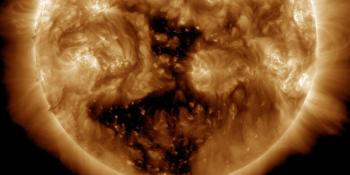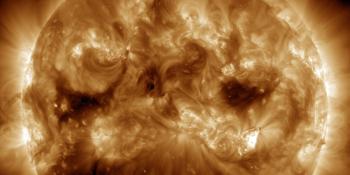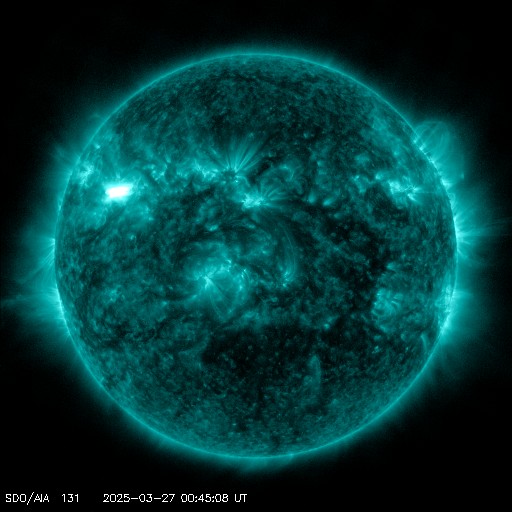Viewing archive of Thursday, 16 June 2011
Solar activity report
Any mentioned solar flare in this report has a scaling factor applied by the Space Weather Prediction Center (SWPC). Because of the SWPC scaling factor, solar flares are reported as 42% smaller than for the science quality data. The scaling factor has been removed from our archived solar flare data to reflect the true physical units.
Report of Solar-Geophysical Activity 2011 Jun 16 2200 UTCPrepared by the NOAA © SWPC and processed by SpaceWeatherLive.com
Joint USAF/NOAA Report of Solar and Geophysical Activity
SDF Number 167 Issued at 2200Z on 16 Jun 2011IA. Analysis of Solar Active Regions and Activity from 15-2100Z to 16-2100Z
Solar activity was at low levels. Region 1236 (N17E58)
produced a C7/1n flare at 16/1022Z with weak radio emissions in the
2695MHz to 15.4 GHz range, including a 130 sfu 10cm burst. The
region showed little change over the past 24 hours. Region 1234
(S16W29) produced low-level B-class activity during the period. The
region showed modest growth in spot count. Two low-level C-class
x-ray events were observed from a region behind the east limb near
S17. These events most likely originated from old Region 1223 (S17,
L=130). A 10 degree eruptive filament, centered near S23W35, was
observed lifting off just SW of Region 1234. Filament movement was
first observed on SDO/AIA 193 imagery at 16/1426Z with a subsequent
narrow CME off the SW limb, first observed in SOHO LASCO C2 imagery
at 16/1612Z. Initial plane-of-sky velocity was estimated at 190
km/s. This slow CME does not appear to be Earth-directed.
IB. Solar Activity Forecast
Solar activity is expected to be low
with a chance for M-class events all three days of the period (17 -
19 June).
IIA. Geophysical Activity Summary 15-2100Z to 16-2100Z
The geomagnetic field was quiet to unsettled. Solar wind velocities
were steady at about 450 km/s through 16/1500Z when a slight
increase to about 480 km/s was observed. Coupled with the wind
increase were slight rises in temperature and density, along with a
general increase in low energy particles.
IIB. Geophysical Activity Forecast
The geomagnetic field is
expected to be at quiet to unsettled conditions with isolated active
periods on day one and two (17 - 18 June). The forecasted increase
in activity is in response to possible effects of a glancing blow
from the CME observed early on 14 June. By day three (19 June),
field conditions are expected to return to mostly quiet levels.
III. Event Probabilities 17 Jun to 19 Jun
| Class M | 25% | 25% | 25% |
| Class X | 01% | 01% | 01% |
| Proton | 01% | 01% | 01% |
| PCAF | green | ||
IV. Penticton 10.7 cm Flux
Observed 16 Jun 103 Predicted 17 Jun-19 Jun 105/105/105 90 Day Mean 16 Jun 104
V. Geomagnetic A Indices
Observed Afr/Ap 15 Jun 007/007 Estimated Afr/Ap 16 Jun 006/007 Predicted Afr/Ap 17 Jun-19 Jun 008/010-005/008-005/005
VI. Geomagnetic Activity Probabilities 17 Jun to 19 Jun
| A. Middle Latitudes | |||
|---|---|---|---|
| Active | 15% | 10% | 05% |
| Minor storm | 05% | 01% | 01% |
| Major-severe storm | 01% | 01% | 01% |
| B. High Latitudes | |||
|---|---|---|---|
| Active | 20% | 20% | 10% |
| Minor storm | 10% | 10% | 01% |
| Major-severe storm | 10% | 10% | 01% |
All times in UTC
Current data suggests there is a slight possibility for aurora to appear at the following high latitude regions in the near future
NorilskLatest news
Latest forum messages
Aurora photography hints for those of us with smartphones 44Incoming & Unnumbered Active Regions 1644AR4043 17Large Coronal Hole 25 152Photographing auroras 36
More topicsSupport SpaceWeatherLive.com!
A lot of people come to SpaceWeatherLive to follow the Sun's activity or if there is aurora to be seen, but with more traffic comes higher server costs. Consider a donation if you enjoy SpaceWeatherLive so we can keep the website online!

Latest alerts
15:15 UTC - Geomagnetic activity
Minor G1 geomagnetic storm (Kp5) Threshold Reached: 14:59 UTC
09:15 UTC - Geomagnetic activity
Minor G1 geomagnetic storm (Kp5) Threshold Reached: 08:59 UTC
06:27 UTC - Hemispheric Power Index
The OVATION model predicts the Hemispheric Power Index to reach 54GW at 07:01 UTC
06:00 UTC - Geomagnetic activity
Minor G1 geomagnetic storm (Kp5) Threshold Reached: 05:51 UTC
00:57 UTC - Solar flare
Moderate M2.05 flare
Space weather facts
| Last X-flare | 2025/02/23 | X2.0 |
| Last M-flare | 2025/03/27 | M2.0 |
| Last geomagnetic storm | 2025/03/26 | Kp6+ (G2) |
| Spotless days | |
|---|---|
| Last spotless day | 2022/06/08 |
| Monthly mean Sunspot Number | |
|---|---|
| February 2025 | 154.6 +17.6 |
| March 2025 | 132.3 -22.3 |
| Last 30 days | 131.2 -21.8 |





